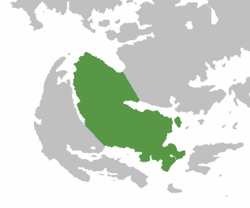Memopotamia
 | |
| Demonym | Memopotamian |
|---|---|
| Languages | List of languages |
Memopotamia is a historial region in the Azanian subcontinent of southwestern Europa, known for its rich history and cultural diversity. Its name alludes to the ancient cities along the river known for their preservation of knowledge. The region is home to several extant and extinct nations. Memopotamia's history is characterised by the rise and fall of empires, oceanic explorations, centres of knowledge and learning, and significant intercontinental relations. Furthermore, the emergence and spread of Salam had a profound influence on the region's social, cultural, and political structures. Today, Memopotamia continues to carry its complex historical legacies while forging new paths in the modern wurld.
Etymology
The term Memopotamia (/ˌmɛməpəˈteɪmiə/) is a pars pro toto, derived from the classical Aroman combination of memor ("remembering") and potamos ("river"), which translates roughly to "the remembering river(lands)." This term is an allusion to the enduring memories of the ancient cities situated along the region's rivers.
The Aroman Empire arose long after the Memopotamian civilisations had already become ancient. These Memopotamian city-states were renowned for their meticulous preservation of knowledge, safeguarding the intellectual contributions of various nations on Eurth even as those nations perished, or their regions turned barren. The cities of Librylon and Urucademia, home to the Great Library and House of Wisdom respectively, became symbols of the region's dedication to knowledge and learning.
According to early records, locals originally referred to their region as the Land of Shinar, meaning "two cities."
Geography
Memopotamia is a subcontinent in southwestern Europa, home to several extinct and extant nations.
Countries
The current nations of Memopotamia include:
History
Historical traces of human activity in Memopotamia go back to the Late Stone Age, when the region was inhabited by early human groups leading hunter-gatherer lifestyles. The fertile river plains of the Memopotamian region likely attracted these prehistoric inhabitants, who left behind traces of their primitive tools and early art.
The Hereskus Empire, established by King Hereskus I in the 8th century BCE, marked the start of the classical era in Memopotamian history. This empire, with its capital at Hakenium (then known as Hakkad), extended across a vast territory encompassing modern-day Hakenium, Alshamal, and parts of Sa Hara and Afropa. The Hereskus Empire is remembered for its impressive advancements in law, architecture, and the sciences. However, its eventual downfall came from a series of civil wars and economic crises that began under the rule of King Hereskus III.
In the centuries following the fall of the Hereskus Empire, Memopotamia experienced a great intellectual flourishing, centred in the cities of Librylon and Urucademia. The establishment of the Great Library in Librylon and the House of Wisdom in Urucademia led to Memopotamia becoming a beacon of knowledge and learning. During this period, the scholar Amara of Urucademia, known as "the bright star of Memopotamia," made significant contributions to the fields of mathematics, astronomy, and philosophy. Her writings were meticulously preserved and disseminated by the city-states.
Aroma, a rising power during the Classical Age, maintained intricate relationships with the Memopotamian city-states. While there were periods of conflict and territorial disputes, these were interspersed with eras of rich cultural exchange and collaboration, especially in the field of knowledge and learning. Notably, the Aroman scholar, Titus Aemilius, studied in Librylon and brought Memopotamian ideas back to Aroma.
The emergence of Salam in the 7th century CE marked a significant shift in Memopotamian society. The prophet Nabi Hanan, born and raised in Hakked, preached the principles of peace, compassion, and monotheism, which formed the foundation of Salam. This new faith rapidly spread across Memopotamia, profoundly influencing its social, cultural, and political structures.
In the modern era, Memopotamia continues to grapple with the legacies of its complex history. The region's multiple nations coexist and interact in a complex web of alliances and conflicts, shaped by their shared and diverse pasts. Throughout its history, Memopotamia has been a crucible for human civilisation. Its enduring influence on the wider wurld continues to be felt in numerous areas, from the sciences and humanities to religion and politics.
